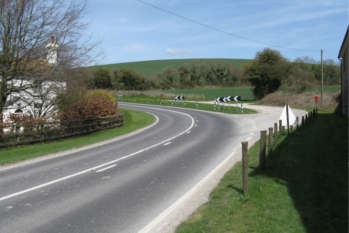New guidelines published today could be used by any road agency in the world to make roads significantly safer, according to a leading safety charity.
Tackling High-Risk Regional Roads, published by the Road Safety Foundation (RSF), contains guidelines initially drawn up to help authorities bid for funding under the Department for Transport’s (DfT) Safer Roads Fund.
The £175m Fund aimed to improve the 50 highest risk local A road sections in England based on a report last year from the RSF.

West Sussex CC received funding to improve the A258 (pictured)
The document is freely available to any road authority seeking to apply 'safe system' thinking to their busy regional roads.
The guidelines, were drawn up with support from the RAC Foundation and the DfT and show how to identify priority sections, along with examples of the cost benefit ratio of potentially life-saving treatment plans.
The document’s author, RSF research director Dr Suzy Charman, said: ’A lifetime of care for a single trauma victim can cost more than £20m. These guidelines have been written to help road authorities manage road crash risk on busy regional roads. This document provides a step-by-step guide on how to use risk mapping and star rating to identify high-risk roads and then develop treatment plans that will reduce their risk.
‘We have identified roads where risk is 20-times higher than on others. Counter-measures are typically simple: often this is down to installing centre-lane hatching; rumble strips and safe recovery zones at the side of the road; protective right-turn pockets; and high-friction treatments on bends.’
Under a star rating approach, roads are video-surveyed, and then more than 50 road features that are known to influence crash likelihood and severity are coded every 100 metres along the route.
This data is combined with supporting records such as speed surveys, road user flows and crash distribution and is uploaded into ViDA, a specialist online analysis tool devised by the International Road Assessment Programme (iRAP).
Safer Road Investment Plans (SRIPs) give road safety engineers an overview of the types of measures that might be effective in managing the risk on their roads and show the economic rate of return.
Road safety engineers can use this information together with their expertise and local knowledge to create a refined and tailored investment plan.
To date, nearly 80 local authority road engineers have been trained in using the guidelines and software to assist their funding bids.
Dr Charman added: ‘Local authorities which have been part of the Safer Roads programme are already embracing the iRAP approach, and are delighted to have the opportunity and budget to improve these high-risk roads. Some authorities have even commissioned the RSF to undertake additional surveys on roads of concern that fall outside of the remit of the Safer Roads Fund.’
Register now for full access
Register just once to get unrestricted, real-time coverage of the issues and challenges facing UK transport and highways engineers.
Full website content includes the latest news, exclusive commentary from leading industry figures and detailed topical analysis of the highways, transportation, environment and place-shaping sectors.
Use the link below to register your details for full, free access.
Already a registered? Login